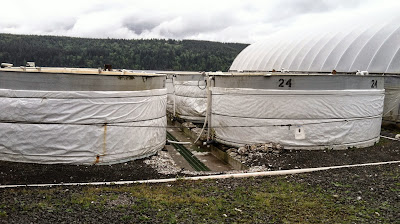Saturday, June 22, 2013
Travel and Ferry Schedules
Sigh! we just missed the ferry home, arriving mere minutes too late to board for the 5:30 crossing, even though the boat was still idling at the Bainbridge Island dock. Did we dawdle too long departing the shipyard? Was it that brief, unplanned detour to purchase a Dairy Queen treat? Should we blame it on the heavy Friday evening traffic? No big deal, the next scheduled run would depart in an hour and we were plenty early to catch that one! There was an upside to just missing the boat... we were at the head of the line for the next crossing and had a superb view of the Seattle skyline during the 8.6 mile crossing from Bainbridge Island to downtown Seattle.
I can't imagine living far away from big expanses of water for any length of time... not cheerfully anyway.
Sunday, May 26, 2013
Quilcene and Oysters
We took a spur of the moment detour recently to visit Quilcene, a small Hood Canal town on the Olympic Peninsula. Quilcene is famous for its oysters, or at least it used to be. Coast Seafoods appeared to be the only company still active in Quilcene Bay, growing spat for commercial resale rather than fresh bags of oysters for retail customers.
I don't often think about oysters, never buy them at the market, and rarely order them at downtown pubs or restaurants. But there's something about being near northwest oyster beds that develops full-blown oyster cravings. Freshly harvested oysters served on the half shell are awesome, briny treats. Barbecued oysters hot from the grill are delicious beyond description, with or without sauces. What do I order when we're in oyster territory... you guessed it, oysters of course.
There are four different species of oysters grown in the Pacific Northwest; Olympia (the only NW native), Pacific, European Flat and Kumamoto. Fresh oysters are tagged by both growing location and species name so buyers and diners can know which variety they have purchased and where their shellfish were grown and harvested. I need to remember this fact in the future.
Still optimistic about finding some fresh, local oysters for a late lunch, we joined the pickups and boat trailers outside the Twana Roadhouse and headed inside to check out the menu. The place was packed with a happy crowd of all ages, decked out in jeans, fleece, sweatshirts and rubber boots. Shrimp season had opened that day and judging by the noise and the smiles, the catch must have been good.
We were really hungry and our baskets of oysters and fries were okay, but this was not the special lunch I had anticipated. Sigh, the oysters were not local, pre-breaded and supplied by a large restaurant supplier and the tangy coleslaw was also a commercial product, not house made. I should plan ahead next time, or at least ask a few questions before ordering.
Has commercial oystering disappeared elsewhere in Washington State, or is the change in Quilcene Bay an unusual occurrence? British Columbia appears to have a thriving industry, or perhaps we have been lucky and cruised by some of the expanding locales (link). More research is definitely required.
Sunday, April 14, 2013
The Other Angeles
Use the term Angelenos and most people think of residents of Los Angeles, the City of the Angels. Well, West Coasters, there's another set of Angelenos farther north up the same coast in the Port of the Angels.
The southerly (California) city, El Pueblo de Nuestra Señora de los Angeles, "The Town of Our Lady of Angels" was officially named in 1781. (history link) LA's San Pedro waterfront is one of the busiest in the nation (link), but I think of it more in terms of tourism and sandy beaches than as a working, commercial entity.
Spanish explorers sailed into the northern (Washington State) harbor in 1791 and named it Puerto de Nuestra Senora de Los Angeles, "Port of Our Lady of Angels," though it wasn't until 1862 that President Abraham Lincoln designated Port Angeles a federal city. (history link) Port Angeles' waterfront is considerably less busy than LA's, blending an interesting mix of small town commerce and a variety of maritime-linked activities.
Centuries of development have altered the waterfront for both sets of Angelenos, but I find a connection with recent history whenever I explore the Port Angeles shore. Fishing and logging have long played a major role in the economy of the region. It's easy to imagine acres of log rafts ringing the harbor, waiting for tug transport to sawmill or for loading on a ship.
This old-timer might have more than a few stories to tell, tales of long hours and large catches. She may look neglected and forgotten, but someone still loves her enough to pay her yard fees. Is she a project in the making, or just a reminder of times past?
Lace curtains still hang in the cabin windows, a reminder that fishing was always about people as much as it was about boats and fish. Did this vessel house a family, or did the fisherman's wife provide this touch to remind him of home?
Surprisingly the stern, at the apparent end of its useful life, still holds a propeller and rudder...
...and, not so surprisingly, remnants of the colonies of mussels and barnacles that also hung on this ship.
Dee's Note: this could have easily been posted in Cruise News, but it feels like a road trip when we head to Port Angeles.
Subscribe to:
Comments (Atom)




















